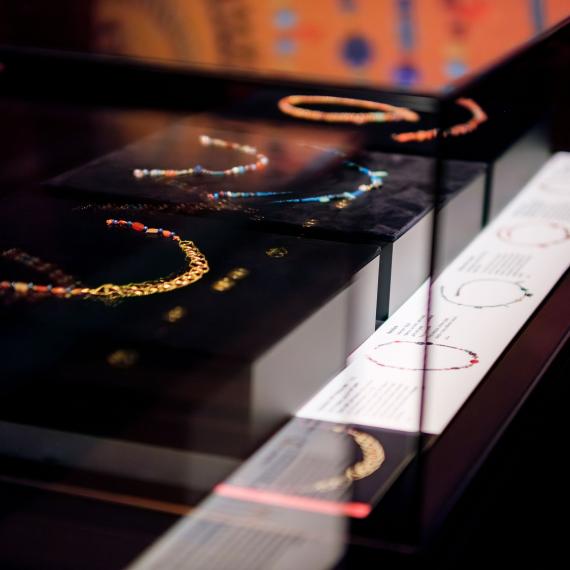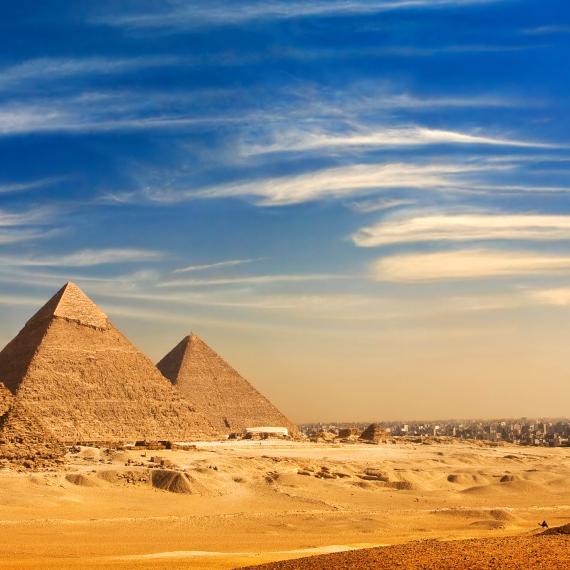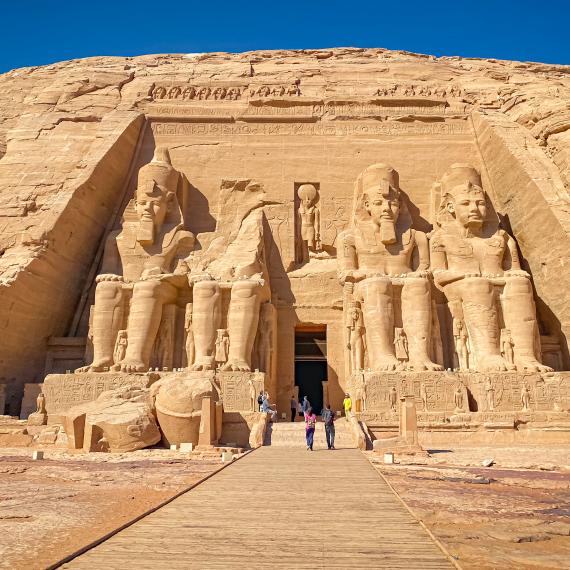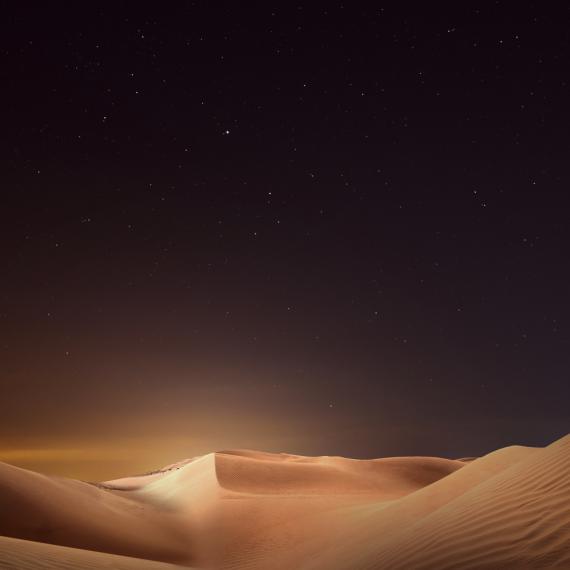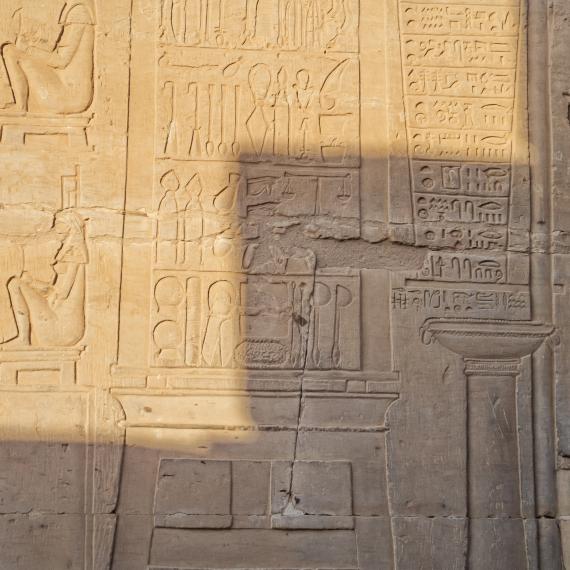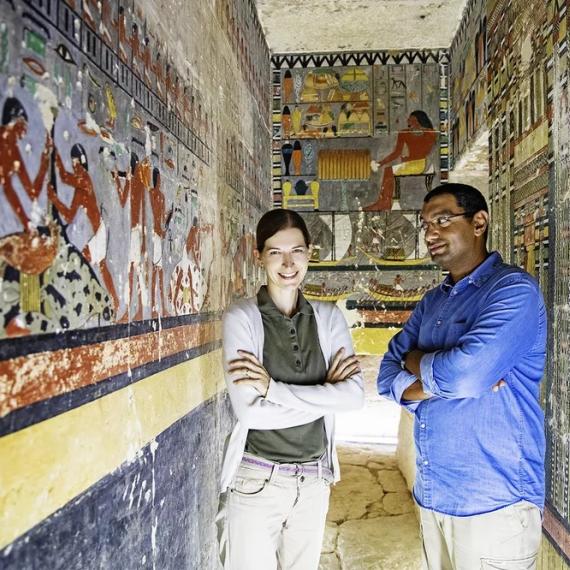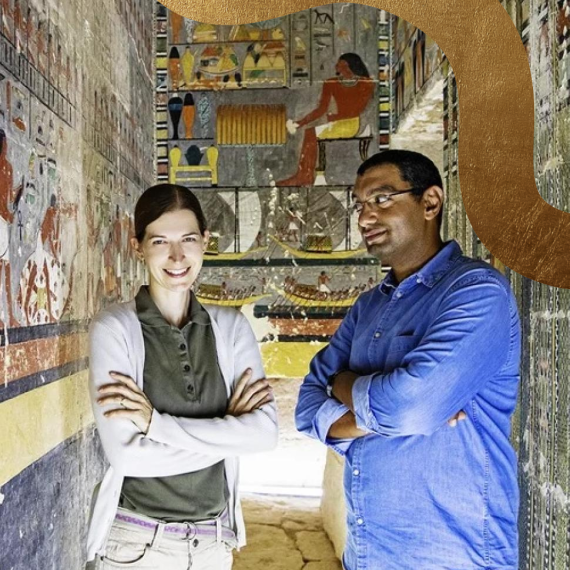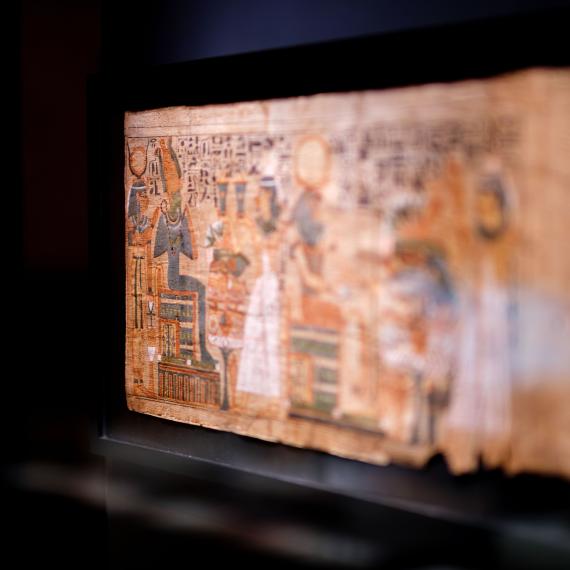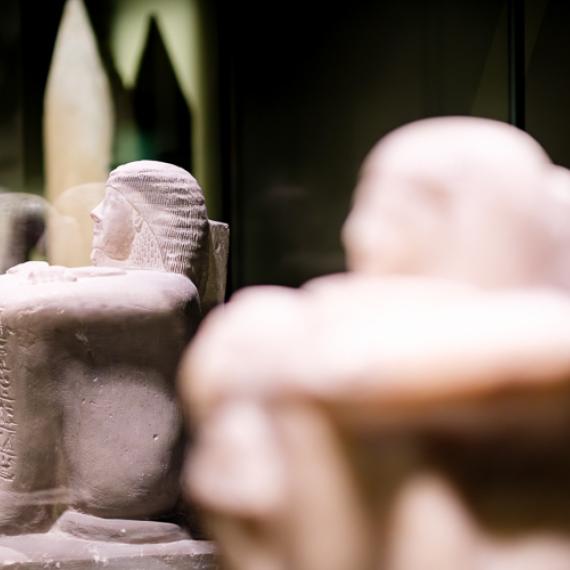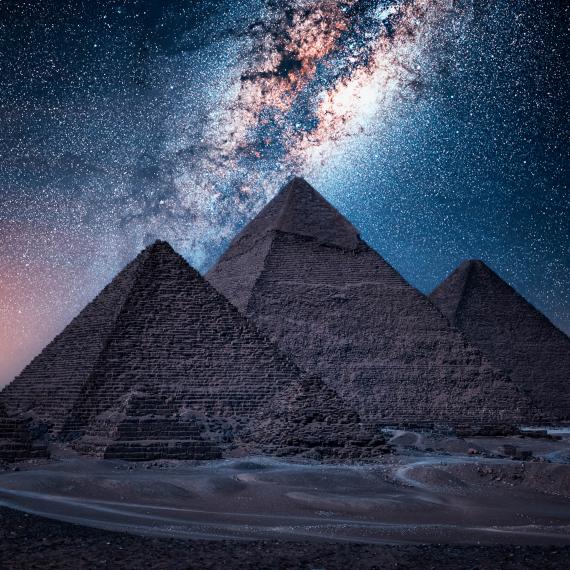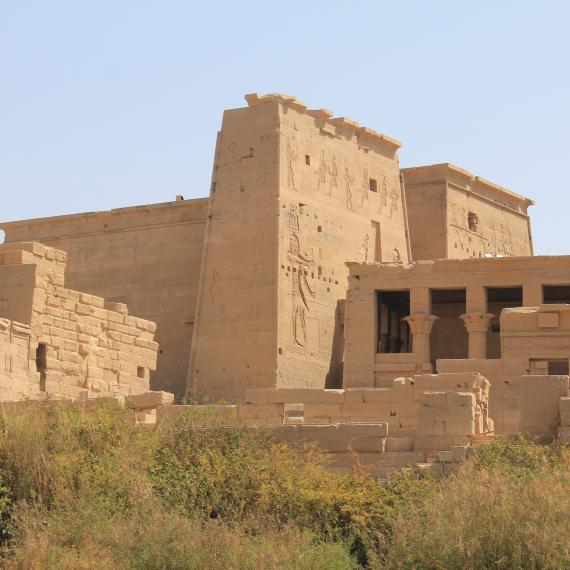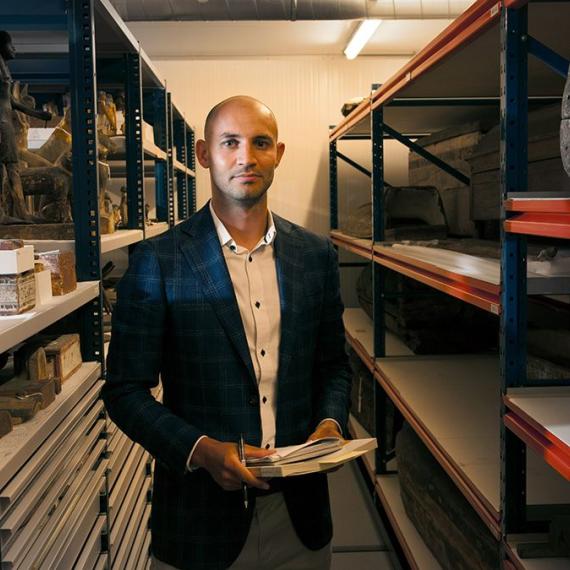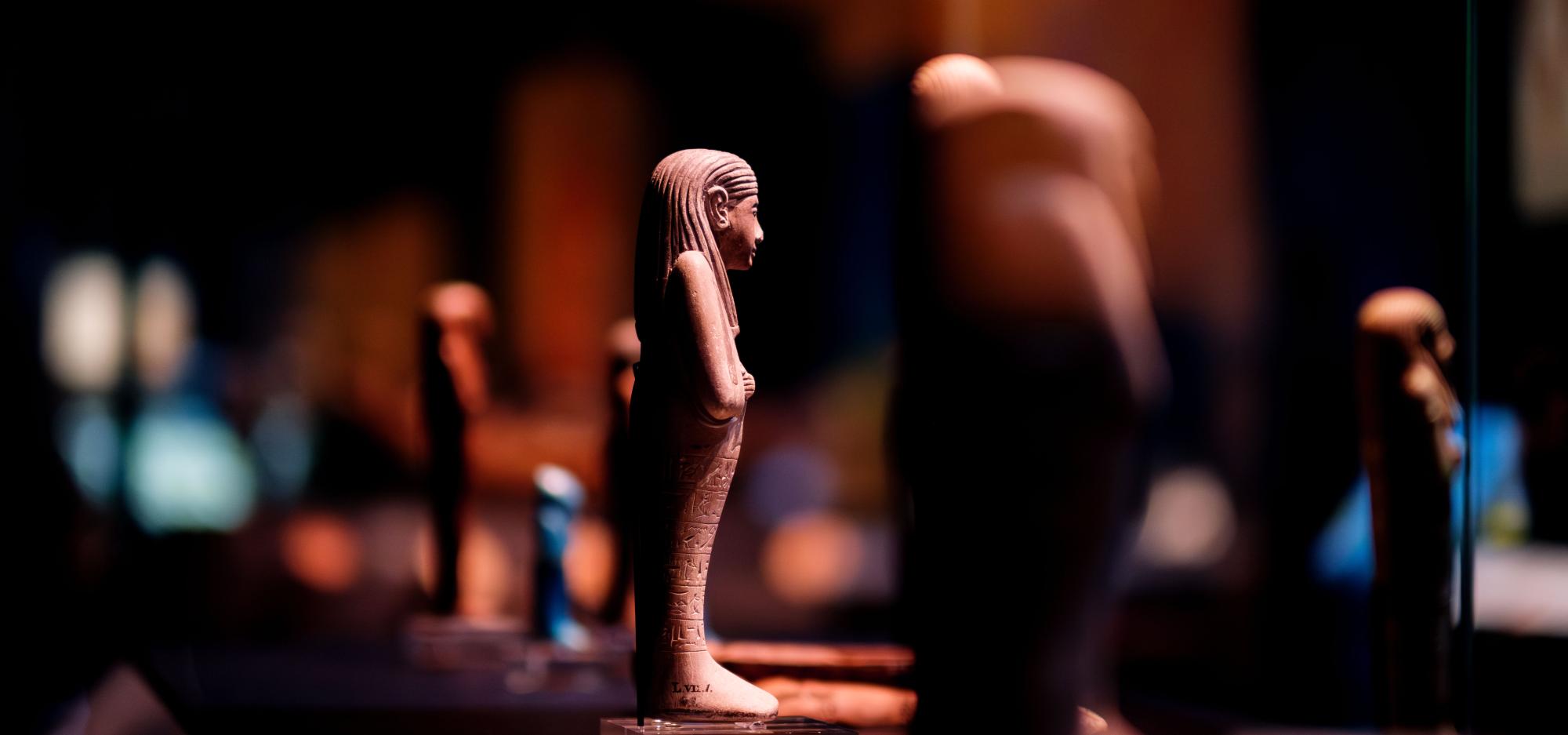
Ancient Egyptian Mummification by Dr Jasmine Day
How, when and why was mummification invented? The answers may surprise you.
Uncover the lost history of this legendary but much-misunderstood practice. (Warning: contains images of human remains) Dr Jasmine Day, anthropologist and Egyptologist, is an expert on Egyptian mummies and the author of The Mummy’s Curse: Mummymania in the English-speaking World. She appeared in TV’s Egypt’s Unexplained Files.
-
Episode transcript
Podcast Introduction:
Welcome to the Western Australian Museum Boola Bardip talks archive. The WA Museum Boola Bardip hosts a series of thought-provoking talks and conversations, tackling big issues, questions and ideas and is delighted to be able to share these with you through the talks archive. The talks archive is recorded on Whadjuk Nyoongar boodja. The Western Australian Museum acknowledges and respects the traditional owners of their ancestral lands, waters and skies.
Event MC:
Welcome to the WA Museum Boola Bardip and to our Afterlife bar and talk series. Before we begin the talk tonight, we would like to do an acknowledgment of country. This evening we are meeting on Whadjuk Nyoongar boojda. We'd like to acknowledge elders past and present. This evening we're very lucky to be joined by Dr. Jasmine Day, who will be giving a talk on mummification for the next half an hour. Could you all please welcome Dr. Jasmine Day to the stage.
Dr Jasmine Day:
Okay. Thank you very much for coming, everybody. I hope you enjoy the talk tonight. I hope you're not too squeamish. <laughs>. I've chosen my images carefully and I'm going to talk to you about Egyptian mummification. But before I say that I'm the president of the ancient Egypt Society of Western Australia, Dr. Jasmine Day, and we hold monthly talks on Egyptology for anyone who's interested in ancient Egypt. If you're interested, it's not about what is your academic degree, are you interested? If you if the answer is yes, please come and take one of the forms I've got down here. I've got a limited quantity list. We, as I said, will welcome anyone from any background who wants to come along and hear interesting lectures on this topic.
We also have social events as well, and we've been going now for, gosh, I think about 28 years even. I've lost count. We've been going since 1996, as it says. Okay, so tonight I'm going to be talking, as I said, on Egyptian mummies. And given the nature of the topic, as there is a viewer advisory that I will be showing, scenes of human remains in the way of x rays, but particularly unwrapped human mummies. Not very many images of that, but a few because I want to be able to show you what you can't see in the exhibition and what a lot of paleo pathologists that scientists who specialize in the medical study of ancient human remains and diseases of human beings, this is the sort of thing that they deal with quite a lot.
I used to go to the International Congress on Mummy Studies, which was held every three or four years in various places around the world and saw some amazing collections of mummies, including things that are not open to the public. These days, we don't unwrap mummies anymore. We regard that as unethical and destructive. Besides, we've got the technology now to scan mummies. It's just unfortunate that a very high proportion of Egyptian mummies have been damaged, if not destroyed altogether by past practices and tomb robbers and also destructive collecting as well in the past.
So, but in the exhibition, you can see several Egyptian mummies that are still complete and completely wrapped. And I'll talk to you in one point about the wrapping and what so important to have examples of that still in place.
So, let's talk about the history of mummification. I need to really start out with the history of ancient Egypt itself, because history of mummification is the history of ancient Egypt. It took the Egyptians over 3000 years to have the ancient part of their civilization from the prehistoric to the early Christian and Muslim periods and the most famous pharaonic period in between. But it also took that long for them to slowly, incrementally invent the process of mummification. It was not invented overnight. And as you'll see what we thought we knew about how mummies were made and why mummies were made might be, well, not wrong, but just not the whole picture. It turns out that what we thought we knew about making mummies was more like guidelines, as the pirates might say, rather than strict rules. So, what you read in children's books about step one, you do this. Step two, you do that. That's super over generalizing.
But let's talk about mummification history. Now. I threaten to turn ancient Egypt's history into a hamburger because there's so much of it crammed in. But I've made good on my threat. This is my diagram. It's maybe a bit easier to understand than an ordinary timeline.
A hamburger with three big patties in it called creatively the Old Kingdom, the Middle Kingdom and the New Kingdom, and like a real hamburger. In between those layers and above and below them, there are other layers, other things. So, if at the start of the burger, at the top, we go from the prehistoric period of hunting and gathering food to the first kings and queens and settlements along the Nile River. This leads us to the Pyramid Age, the old Kingdom, the famous pyramids. Then there was a period of famine and fighting when the kingdom broke apart. But gradually they got themselves reunited again and had a golden age. We refer to as the Middle Kingdom. They literally had lots of gold. Someone wrote to one of the pharaohs and said, in your country, gold is just lying around on the ground. Can we please have some? I'm not making this up. So that was the Middle Kingdom. But being rich pickings. Egypt became a hotspot for invasion. And as you'll see in my shot, wherever it's green, that's where Egypt was ruled by foreigners. In fact, Egypt continued to be ruled by foreigners right up until the 20th century after this, which says a lot.
So, the period which followed the golden age of the Middle Kingdom was the second intermediate period. They were invaded by the Hyksos, people who brought horses and chariots, but the Egyptians got their own horses and chariots and beat them out of there and took their country back. And that led to the age of the warrior Pharaohs in the New Kingdom. This is famous for Ramses, the second the great build up and took place. The third, the great warrior also for Tutankhamen and his father, Akhenaten and Akhenaten's chief wife Nefertiti, also famous for Hatshepsut, the woman who became a king. You can google all of these interesting people if you haven't done so already. But Egypt lost its power after that during the third intermediate period. And guess what? They then got invited again, this time by the Persians, the new superpower of the ancient world. But the archrival of the Persians was Alexander the Great. He came along, declared himself Pharaoh, kicked out the Persians. It was actually very popular for doing so, but then he went away and died in India. So, in the meantime, his general Ptolemy came back and took over Egypt and founded the Last Dynasty, the last family of kings and queens.
The Ptolemy's, the last Ptolemaic ruler who was Macedonian, was Cleopatra, the famous one. She was actually Cleopatra the seventh. Don't get mixed up with the other six. So unfortunately, after Cleopatra died, Egypt was taken over by the Roman Empire. They just wanted their hands on that because they could use the rich farmland to grow grain, to make bread, to feed the Roman army. That's why they wanted Egypt. They took it over. But eventually, about four centuries after Christ, the Romans turned Christian, and they forced Christianity upon Egypt and the many other countries that they ruled as well. And so, the temples were shut down, rebranded and reopened as churches. The priests were out of a job. This is how we lost the hieroglyphic language initially and eventually. Well, that was that was the Byzantine period when the Christians started up in Egypt. That survives today is the Coptic Church. But in approximately 641 A.D., the Muslim armies came to Egypt and took over the country. It's now predominantly Muslim countries. So that's how there's been so much change in Egypt. But there also are also aspects of culture that have always remained the same.
If you ever want to read about what hasn't changed in Egypt, what's the connection between all these layers of the hamburger? Read a wonderful book by Anthony Satin called The Pharaohs Shadow. Very interesting, that book. But let's go back then to the beginning of the burger. At the top of the burger, at the beginning of ancient Egypt, what you're looking at here is actually a piece of cloth impregnated with 11 secret herbs and spices. But what are they and why are they there?
Well, Egyptologists thought that the Egyptians first tried to make mummies in the age of the pharaohs. And certainly, they perfected the process at that time. But a new Australian and UK study led by the Jana Jones of Macquarie University and Stephen Buckley of the University of York in the UK has revealed that the Egyptians started the mummification experiments wait for it 2000 years earlier than we thought, 2000 years, not 100 years or 202,000 years.
What that takes us back to the Neolithic, the prehistoric period. It takes us back to the early dynastic periods before Egypt even existed as a country, when people were still running around in tribes hunting and gathering, they were trying to preserve human bodies. Why and how? We don't know. Dr. Jones found traces of resins on wrappings from body of bodies, from Badari and Mostageda. And they seem to have preserved some of the soft tissue around them. So, where the wrappings were touching the body, a little bit of flesh had been preserved on the surface. Dr. Buckley analysed and found that there was a pine resin and aromatic plant extract a plant gum or sugar, a natural petroleum source of some sort, and some kind of plant oil or animal fat and these were similar to the antibacterial substances used by the Egyptians in true mummification that we think of thousands of years later.
So, is mummification even older than ancient Egypt? It appears the answer is yes. Why were they doing this? Will we ever learn how and why? But let's return for now to the original theory of the origins of mummification. From the good old days when we didn't realize that they started running around with these 11 secret herbs and spices quite so early in their history. If we go to the period before, shortly before the beginning of the Kings and queens, the dynasties, the pyramids. People were being buried in the desert like this. So being wrapped in a mat quite often, not just dumped in a hole, but wrapped in a mat, and they would put food and drink in the grave in vessels of pottery because they believed that you had an afterlife. Already they believed. We have evidence from graves, from the prehistoric period in Europe way older than this, that people already had afterlife beliefs even back then. So, this is very old, scientists have argued that religion is actually hot wired into the human mind.
So, in the beginning, everyone in Egypt was buried in a simple, shallow desert grave like this one. But throughout its later history, only poor people were buried in this way because rich people had rich things to be buried with them gold, gems, jewellery, other things like that, perfumes, cloth. So, they would dig down under the sand, create a room inside the rock, a tomb, and try to seal things in there away from the robbers. It generally didn't work, but they were trying. This turns out to be significant, but I'll come back to that in a moment. I want to show you the first image of human remains here. So, this is what happens to that body when it gets put into the sand, because after a period of time, the sand, which is like a giant sponge, sucks the moisture out of the body and with the moisture goes the bacteria that causes decay. So, what you get is literally a human sultana. It's brown, it's wrinkly, it's dried out, it's still a person, but it's brown and wrinkly and dried out. It's a human sultana. So, this is some of the pottery that was buried with this lady. It's an adult woman. She's buried with a knife to do the cooking in the afterlife. There is no escape from kitchen work. Um. There’s the back of her head, her spine, her feet, and the stringy remains of the red wrap mat (11:55-12:00) in which she was wrapped. So, the theory goes, and again, we have no writing, no texts to tell us or confirm if this is right. But the theory goes that these shallow graves were surely uncovered by jackals sometimes, or they the sand would blow off the top and they would see these preserved bodies and conclude that the reason why your soul lives forever is because your body lives forever.
It's a very common human belief, including today, that the way you treat the body of a dead person is important because it will affect or interfere with their passage to the afterlife. And the eternity of their soul depends on how you treat the body. So, the Egyptians were not different in that respect. They concluded that you must need the body. And the thing is, if you were then burying bodies away from the scene, you're burying the wealthy people in rock cut tombs. Their bodies are not being preserved by the sand. They're lying in a stone sarcophagus or a wooden coffin. So, what are you going to do to preserve the spirit of the pharaoh? You're going to have to intervene and invent artificial mummification and copy what the sand used to do in creating human sultanas by drying the body out. Now, it took them a long time to work this out, but to work out the steps of natural, sorry, artificial mummification. But the first step they discovered was that the body starts rotting away in the stomach. It's rather obvious when you're looking at a corpse lying there. If you just leave it there, the stomach starts to swell with the gases being produced from decay. It's very unpleasant. It looks horrible, smells horrible. They want to stop all that. So, they would put a cut in the abdomen and put the hand in and remove the liver, the lungs, the stomach and intestines. Usually. Again, we've looked at mummies. We've done surveys and found a lot of mummies don't have that exact combination of organs removed. It's more like guidelines. But when they took these out, they would put them into what we call Canopic jars. You don't want to throw those organs away because what happens to the body happens to the spirit. You don't want to be gutless in the afterlife now do you. So, they will put them in jars protected by four gods Imsety, Hapy, Duamutef and Qebehsenuef, the four sons of the God Horus.
And these were particularly good respectively the liver, the lungs, stomach and intestines. I'm cheating a bit. These are the canopic jars that they see in Hollywood films. These actually come from late in Egyptian history, long after King Tut from the late period, as I mentioned, the time of the Persians and the early Canopic jars in the middle and New Kingdom, they had the head of the dead person like King Tut's canopic jars. And in the old kingdom, canopic jars were just boring stone boxes, square boxes.
But of course, taking the organs out of the body is no guarantee of the preservation of the rest of the body. It will just continue to decay. It slows it down to eliminate the main source of moisture in here. But what else can you do? You can use something naturally found in Egypt, easy to acquire, but dries out the body like the sand used to do and it's called natron. It's a type of salt. It's like sodium carbonate, sodium bicarbonate and sodium chloride in some natural proportion and combination. It's a little bit like table salt plus baking soda. Now that you know this formula, you can go home and mummify the cat. I actually got an email years ago from a young girl. She said, “I've just mummified a rat. What do I do now?” said, “Give it a decent burial”.
So, my life is interesting sometimes. So, this is what you get the natron from. It's from the wadi natron lake in Egypt, the lake isn't always there. It forms in the couple of days of year when it rains. Rain is so rare, and the natron is in the soil, but it gets into the water to make super salty water. Then when the lake evaporates a short time afterwards, you can go around and collect the solid lumps of natron. Here's some examples. Some evidence from the British Museum of pots and bags of natron from thousands of years ago, from the embalmer’s studios and a modern sample of crystals from Wadi natron. So, I want to show you how they would use these. They would put bags of nature on inside the body to suck up the moisture from inside the body because a human is a rather large animal, and you have to put the bags inside. Those would let it be taken out but not thrown away. They would be carefully buried near the tomb. Again, they contain a part of the person, and they affect the person's spirit. We would say it contains your DNA. So - not that they knew about that, but they would put the bags inside the body and then they would also dump natron over the body to suck the moisture out. Plus, not forgetting that they had natron, they would put that on the organs as well before they put them into the Canopic jars to dry them out.
So, I want to show you a series of several images of human remains now. This is the body of a man called Hora in the Field Museum, and he's displayed standing up like that long ago, somebody unwrapped just his head, though that's often an indication that they were checking out of the mummy was genuine or not because believe it or not, there were fakes back in the day… another story. Mummies…. mummification does preserve hair, but this guy's got no hair. Why? Because he was wealthy, so he would shave his head and wear a wig instead. His nose has been squashed by the wrappings. This is because when you first make a mummy, it's like soft leather, but then it hardens over time. It needs to be a bit soft at the beginning.
If you want to position the arms in the royal position or some other position for other people, I want to show you the body of a whole person now that's been unwrapped. So again, the human Sultana effect. This is Asru, a woman about 50 to 60 years of age. She was a chantress, a priestess, a singer at the Temple of Amun at Karnak, which you can visit today. The temple is still there in Egypt, very famous. And you can see from her body, which unfortunately was unwrapped probably about a century ago, now that the hands and feet and head look very large, they're not changed in size. In fact, the rest of the body shrink around the bones, and it's really thinned out. You can see the hips sort of sticking out. So that's typical of mummification. I say that if you go on an extreme diet, you have to be very careful. You never know what might happen.
Okay, So I'm going to go to the next image now to show you, her hands. And these are so well preserved, they've got her fingerprints off of her hands. The have a way to get her fingerprints off her hands.
Okay. So, we also think when we think of mummies of the removal of the brain and the brain here has been taken out of this mummy, it's actually an X-ray of a mummy head and the brain has been removed and somebody is sticking a metal rod up through a hole in the nose bone. Now, you know, it's a mummy when there's a hole there because there shouldn't be a hole there. When you're making a mummy, you take a long on rod and you smash through the smooth bone at the upper portion of the nose to take the brain out. Now Hollywood movies are notorious. They say you swizzle the brain on a stick and whip it out like the 1999 movie said. Wrong. Or they say you pull it out in pieces like some older books or children's books tell you. Wrong. We know from an experiment with the human body, which we'll talk about near the end, that actually what you do is rely upon, number one, the heat in Egypt. And number two, the brain consisting of a lot of water. And you stir the ball, the brain, like a big bowl of porridge with that hook for about 10 minutes, tip the body up and the brain just comes out as water through the nose, which would explain why we don't have a canopic jar with a brain in it.
There you go.
So, another step that often gets overlooked is that they would usually in the best mummification, so they would seal the body from any further moisture, getting in with some kind of plant resin. The evidence for which we find, for example, in the British Museum, the Egyptians are great. Sometimes they label their own artifacts. This is pot of fresh resin. Thanks, Egyptians, for making making our job easy. I wonder what was in this pot. Oh, save the money for the experiment to find out what was in the pot, just read the label.
Okay, so amulets and wrapping. This is a whole stage in itself. The amulets are objects, usually in the form of jewellery that have some magical function to preserve some aspect of the body, some part of the body, or preserve its functions and the colour, the shape and the material from which the amulet is made is crucial. Most mummies have no amulets, some have a few. Occasionally you find one that's got a whole stack. This is a cheat because they've taken amulets from many mummies and put them over the top of a model of a mummy to show you if you had a complete set, which most people didn't because it was too expensive, what it would look like. So, there were spells, you know, explaining which part of the body, which part which amulet goes on. And it was very complicated. But in real life, who can do it? Only museum curators, I think. I want to talk to you about one famous amulet that you'll see a lot in the exhibition. People might think that Egyptian art is kind of random, but it's not the way it depicts animals and other creatures and objects is anything but random. And if you know the stories of Egyptian mythology, which I'll be telling two weeks from now, back here again, if you'd like to come to that one, it will explain the artwork to you.
So, scarabs, we often see a carving of this famous dung beetle from Egypt that consumes animal dung. It's at the bottom of the food chain. Why would you put that as a sacred object? Why would you make a heart scarab that you wrap onto the mummy over the heart? Why would you put a spell on the bottom saying to the gods, you know, please let me into heaven? I've been a good person, I promise. Why would they make so many tiny scarab amulets? carved from stone or moulded from faience, which is a ceramic glaze. Well, here is a scarab beetle. And notice those funny little front feet, they crawl onto a big animal dung, pat, and pull off a piece and pat it into a ball and kick it along the ground. Then they bury themselves with it and uses the food source during the dry season and lay their eggs in it. And the babies have a food source when they hatch. Then months later, all these scarabs come popping out of the ground. Now they don't eat people and I don't crawl under your skin and your brain like it shows. In the Mummy movies, these strictly eat animal dung and what it looks like is like went underground and died and got buried. And then they were reborn miraculously and came up from the grave. And when you think about it, the sun does the same thing. It dies in the evening, but then reappears on the other horizon on the other side the next day. They assume that the earth is flat because let's face it, it looks that way. And so, the sun sets and rises, and the scarab sets and rises too. So, they show the sun God Ra as a giant scarab pushing, not a giant ball of poo, I'm glad, but a… the sun pushing the sun through the sky. Now the word for eternal life, or, or the power of eternal life is Kheper, it means, you know, to live, to live eternally. Kheper, and Kheper is the name of the scarab beetle. And if you look at Tutankhamen's full name, it's Nebkheperure Ra Tutankhamun. So “the living manifestations of Ra is his pre name, ah, pre nomen.
So, they would have this this word, Kheper, in the pharaoh’s names and in other texts as well. So that's what it does. It gives eternal life like the cycle the eternal cycle of rebirth to the person who is wearing this, be they dead or living, it gives them eternal life. And I've got my own scarab ring on tonight from Egypt. There you go. So, it's not random at all. It's observation of nature and attributing significance to it.
Everybody knows about the wrapping of mummies, and they often were wrapped in scrap cloth, not in perfect bandages, which were really reserved for the very wealthy, especially kings and queens. Notice that when a mummy is complete, it looks like the one on the bottom right-hand side, like a cocoon. It does not have free arms and legs so that can walk around and strangle people. Okay, so there's a little lie they tell you. For those of you watching the film tonight, and I'll be going to that to. Just ask me afterwards about the film. So, the outer layers would have better quality of cloth because who's going to look in here, right? They might be decorated panels inside and they would usually put a shroud or two layers of shrouds or two over the outside like that, and it would look like the one on the bottom right. So, I'm going to show you an image of a wrapped mummy. Now, these are very rare. Most museums, particularly overseas, if you go to museums, a lot and you see mummies, they are not in this nice state, still completely wrapped.
The ones in our exhibition here are completely wrapped because the curator of the Rijksmuseum had the foresight to say, “We're not going to unwrap these; it might damage them.” Good on you, mate. You can still see on the chest of this man the flowers his wife gave him at the funeral. And these are blue lotus flowers still preserved in the air of the tomb.
So, the twilight of mummification. Why did they stop? I've mentioned the coming of Christianity and the change in belief about the necessity of preserving the body. But in the meantime, toward the Greek and Roman period, mummification became cheap and nasty. They didn't spend as much on materials, but they charged as much as they could. They realized if you make it cheaper and nastier but more affordable, more people will get mummified, including children now, who never usually used to be mummified unless they were princes or princesses. And so, you have ordinary people here being mummified. We call this a democratization of mummification. There's a little boy up the top, about five years of age and a little girl. What killed most people in ancient Egypt was disease, which doesn't necessarily leave a sign on the body. That's why you get a lot of young people dying. Another thing we notice about mummies of this period is the decoration changes to look in Greek or Roman in style. He's a classic Roman period. Mummy from the British Museum. He's not wrapped in a coffin, but in a cartonnage, which is like a shell, like a giant eggshell made from papier mâché and decorated. It's cheaper than wood. Wood had to be imported. The local species of wood in Egypt were not large enough and proofed enough against wood borer insects to be able to be used in coffins. So, they imported wood. So, it was expensive. But this was cheaper, cheap and cheerful, cartonnage. So Artimidoris is this man's name. He's got a fayum period portrait. Looks like the ones from Pompeii, doesn't it? And was one of these taken out of the mummy that's in the exhibition in the Mummy room. He's got a gilded falcon collar, he's got Egyptian gods and he's got an inscription in Greek that you can't see here that says farewell Artimidoris, complete with a spelling mistake apparently for those who would read Greek. But you see, that means that he is Roman, but he's also Egyptian, but he's also Greek at the same time. He probably identified as Roman, but we could think of him also as a multicultural mummy as he would have been a multicultural man. This is what Egypt's culture was like around the time of Christ. In fact, I think this man lived during or shortly after the life of Christ.
But the resurrection of mummification. This is how we came to understand a bit more about the process. I mentioned that experiment in which we liquefied a mummy's brain and tipped it out through the nose. Here it is, folks. This is Bob Brier, his professor Brier, a good friend of mine in the United States. He was Mr. Mummy on TV in the US in the 1990s, and in 1994 he and his wife, Pat Rembler and his team recreated using the method I've just described, the dry mummification technique. They applied it to a body donated to science and successfully made a mummy and in the process discovered some details of the process, including the brain I've discussed. But this upstart comes along another friend of mine, Stephen Buckley, whom I mentioned at the start working with Jana Jones, and he said, why is it that the mummies of some of the pharaohs have natron sunken into their bones on the x rays? That could only happen if the natron was in solution like a natron bath. So, what was going on? He said, “I'm going to try mummifying a person in a bath of natron”.
People said, “Steven don't do it. In the 1970s, they did it with small animals and I turned to goopy slush. Don't try it.” But he tried it anyway and he made it work. Now there's a documentary on this called Mummifying Alan. The body he's got there is that of the taxi driver, Alan Billis, in the bottom right there with his wife. Alan was the winner out of a large number of people who said, "Pick me, pick me to be your mummy when I die”.
He was dying of emphysema, so he volunteered for this experiment, was chosen and there he is, a mummy. So, one of only two people arguably to be mummified by an authentic Egyptian method in modern times. This leads us to the film tonight. For those who are going on to see the film at 7:30, and I'll be winding up in a moment, this film, The Mummy from 1959, was not the first Mummy film, but it was the first colour mummy film and the first British mummy film and the first one by the horror studios, Hammer, Hammer Horror, very famous. And it stars the two famous horror stars, Peter Cushing and Christopher Lee as the mummy, and Peter Cushing is the archaeologist. And I mention this film because there are two mummification scenes in it, one of which is pure Hollywood, where the mummy is being made or actually a living man is being mummified, which doesn't work by the way. They don't show the brain being taken out, but shows tongue being cut out to explain why mummies don't talk. It was actually because it had long since been established from Hollywood movies years before that, mummies couldn't talk because the masks and the makeup stopped the actor from moving them the face. That was the real reason why. But they just made an excuse for it in this film. So, showing mummification as torture is a bit as barbaric is really, by our modern standards, rather racist. But this is an older film, so you sort of take it as it comes. But there's another mummification scene of the princess Ananka and she's mummified in a bath of natron. They don’t show you in detail. It's just very brief in the flashback sequence, but they show her in a bath of natron. Now, could this be that by accident or design, they have hit upon the answer of how some of these mummies were made? Were some mummies done in the bath and others were done with the drying method? Did they change? Did it depend which studio you went to? Did it depend on the cost? We don't know. If anybody wants to find out more about mummies. You can try and as a researcher and get into this stuff because we want answers anyway. Just finishing off with a bit of amusement. The coffin of Ananka, the prop used in the film, which is not 100% accurate, particularly those lotuses in the hands, uh, this is in Perth! but not our Perth. It's in Perth, in Scotland. Perth in Scotland, I went there about 15 years ago to the Perth Museum, met the curator, Mark Hall who very kindly with no notice whatsoever, let me into the basement with my two friends to look at the Egyptian coffins and all I could see when I turned around was this thing. I said,
“Oh, my Lord, you've got the, the coffin prop from the mummy movie from ‘59 how’d it get here?” he said, “Oh well, they used to take props from movies around to advertise the films back in the day, and then they would just dump them if they didn't want them, well sell them. Here, they just dumped it in our town, and it was standing for years in a department store, in the window is a dummy to decorate, to decorate the window and then they gave it to the museum, and it's been here ever since.” I said, “dude! get that on display”.
So, they have now preserved this, they've conserved it, cleaned it, and it's now on permanent display at the museum. So, you can go to Perth and see Ananka. Last of all, if you're interested in the things I've been talking about, not just mummies, real mummies, but mummies in popular culture, mummies in movies and what's the connection between the two and what's the implications for the ethics of displaying human remains? This is the book to read because I wrote it. I basically wrote the book. I always wanted to read. This was my doctoral thesis, but it's written for the public and it's The Mummy's Curse: Mummymania in the english speaking world.
You can get that on Amazon, you can get it as e-book, just search it up on the Internet and it's all over the place. So, I'll stop now. Thank you very much for listening. Don't forget our Egypt society flyers and do we have any quick questions at the end?
Audience Member 1:
I'd just like to know why is it called a mummy?
Jasmine Day:
Okay. It's to do with the evolution of words and language. Originally in the Middle East, centuries ago, the Arabs used to use ground up bitumen, that black substance that comes from the ground. They would grind it up and use it for medicine and, um, sorry, I’ll say it again, the Persians were using it and they called it mum. And then the Arabs took over the practice and they called that black stuff, mumia. It just means the black stuff and all the dark coloured stuff. And then when they started finding the remains of the Egyptian civilization that the Arabs were living among, when they came to Egypt, they called the bodies, the ancient bodies, they called them mumia as well. And then the result of the confusion between the bodies and the bitumen. And they weren't just grinding up bitumen and eating it. They are now starting to grind up mummies and eat them. I'm not making this up. And then Europeans got onto it, came to Egypt, were raiding the mummies, trying to elude the Arabs, trying to stop them from stealing not not their cultural heritage, but stealing what they saw was an expensive drug and the Europeans would smuggle these mummies to Europe, grind them up and use them for medicine. And some of the Louis Kings, I think in France, had a pouch of mummy on their belt. They thought that if you mix it with butter, you can put it on a wound and it will staunch the flow of blood and so on and people were swallowing the stuff.
So, at the same time as Europeans were accusing everybody else of being cannibals, they were cannibals themselves eating mumia. And when the Europeans came along, like later on or the British, the word corrupted a bit further into mummy, mummy. But it's got no relationship to the word for mother in English. That's the history of the word.
Audience Member 2:
I was just curious. You mentioned that they removed the organs in the body, and they preserve them as well. And you mentioned that they removed the brain, but you didn't mention preservation of the brain. Is there a reason they don't do they not value that?
Dr Jasmin Day:
It's gone. It's liquid, it's on the floor, it's in a sponge of some sort. One thing that we have occasionally found, particularly when people are looking more carefully now in Egyptology, rather than throwing things out, saying that's a dirty old bit of cloth. They've found embalming caches near tombs. So, I remember seeing a video of my friend Dr. Salima Ikram, examining an embalming cache, and there were pieces of screwed up cloth that had nothing in them but may well have absorbed fluid from the body, including possibly the brain. Another thing they found rather unusually. You know how they say, oh, the heart was left in the body? Well, it depends. It's more like guidelines. In that tomb, they unwrapped one cloth and they found that the tomb owners heart preserved in the cloth. So, it looks like there was not a hard and fast rule about actually how to do this stuff. And I mentioned there would have been more like provincial traditions or local embalming studios with their own method of doing it, but they simply could not preserve the brain.
I did once handle the head of a mummy, which unfortunately was dissected in a botched experiment at the American Museum of Natural History in New York, New York, in the 1950s. And I had the skull of this mummy in my hand, and it was rattling, and I thought, that'll be the brain. And I carefully put the skull down and there were little black flecks of something on my palm of my hand. And then I found that there was an envelope nearby with “brain” question mark written. I looked inside, was full of these black flecks. So, the brain had shrunken down to the size of a golf ball and was rattling around inside the head. So, you can't get that out through the nose once that's happened. So, it's really impossible to remove the brain. One thing I didn't say was why did they not just cut the top of the head off and take the brain out? But what you do to the body happens to the spirit. You don't want to flip top here in the afterlife. You don't want to mess up the face, right? So, you go by the nose. That's the least obvious way.
It's a bit of a trade-off, a lot of these things like that and the evisceration, taking the viscera out are a trade-off between the ideal of keeping the body complete and the reality of having to take it apart in order to preserve as much as you can.
Audience member 3:
Okay. I was just wondering, you said that the original mummies were like 2000 years before, <inaudible> and you said we don't really know why. You did mention that they typically do this to preserve the body in the afterlife. Are there any other theories that you might believe or is that what you kind of feel?
Dr Jasmine Day:
It's very difficult because we don't have any written records about the rationale of people who did mummification. It was a very secretive business. It could make people perhaps rather wealthy and we're not going to give away their trade secrets of how they did it. As for why they did it, well, that's sort of bound up with it. I think it was one of those things that was so widely known that people didn't write it down. But then thousands of years later, when beliefs change, it's all lost. But as I said, we've got so many comparisons with other societies and with religious texts in ancient Egypt, more like spells of the afterlife talking about the preservation of the body being related to the preservation of the spirit. M-My theory is this If you watch a body decay, which is horrific, but this has been done, you know, in science, places like the body farm where they study the decay of human bodies in crime scenes that have not been buried, but ah, whether they’re on the ground rotting away or in the back seat of a car or something, people donate their bodies to sites for these experiments in the United States, and they study the bodies rotting away and so they can look at the insects on the bodies and work out, depending on the stage of development of the insect from the pupa, how long has the body been there for which helps them to solve the crime. Okay, really get into the stuff. There's, there's books on this that you can buy. And the comparison there is if you read about this and you look at the stages of decay of the human body, it falls apart, the head falls off, the arms and legs fall off, the stomach bloats and the guts pop out and things like that. And apart from being obviously horrific and all that being accelerated in a hot climate, so you better bury that body very fast. And thus, there are many traditions like Muslim tradition, bury the body within three days. Things like this is the reason why. And I think what they thought was that just as the body, if you don't stop, it will fall apart, the spirit will fall apart. And they have beliefs about what we would call a spirit, like a singular entity actually consisting of a variety of things, including the name, the shadow, the appetites, the ka, the soul that comes into the tomb and flies around in the world, the ba and then other aspects as well. They thought I would say that they thought that the human being is like a Lego set that's threatened to get smashed when you die. As it is, the spirit and the body separate potentially. And then each one smashes into fragments and all spells for the soul. And all of these spells and physical intervention for the body are to do with bringing all those bits back together and then combining them again. And in the exhibition, you see there's one Ushabti figure, a servant figure, and you can read about what those do in the afterlife. And it's an unusual one because it shows a man grasping his spirit, a guy grasping his soul in the form of human headed bird, grasping it to himself. So, it's trying to keep it, keep it together. We talk about keeping ourselves together. They were trying to keep themselves together and fight nature, because what nature does to the human body is horrific. And in other practices in other civilizations, they'll do things like burning the body to make it stop or bury it quickly and don't look at it and things like that. Well, mummification will also stop that. Actually, artificial and deliberate mummification, mummification is really the third big way of disposing of human bodies throughout human history. Maybe not so much today, but there was a time when it was as almost as common as burial and cremation throughout the world. You can get books about mummies around the world, even kids’ books will give you a lot of answers on this. But certainly, with the Egyptians as opposed to other civilizations, they were trying to keep it together, the body and the soul together and keep the components of each one together in themselves.
Audience member 3:
Thankyou
Dr Jasmine Day:
That’s anthropology, I’m an anthropologist.
Audience member 4.
Um, so you mentioned that they've been doing mummification since the prehistoric period during the times of foreign invasion into the Egyptian kingdoms. Did… was there like a reduction in mummification due to you know, the imposition of the foreign religions or whatnot or?
Dr Jasmine Day:
The short answer is we can't know because we haven't got, you know, preserved every single mummy from every single period that we can count them all and do statistics.
And so, it went down, or it went up. What we can say in general observation is that, ah, the practice of mummification didn't go away. It was very popular. The coffins, they went on and on and on. In fact, if you look at things like the Persian period, if you didn't know the Persian, there was a Persian king sitting on the Egyptian throne. You'd think it was an Egyptian king on the throne because the artwork doesn't change, the beliefs don't change, the mummification doesn't change. It doesn't go away. Whether there was an impact in terms of fewer people being mummified, we may never be able to measure, but it obviously wasn't such a dip that it threatened the continuation of the practice.
It has been commented that Egyptian religion and associated practices like mummification and funerary goods and so on were extremely resilient in the face of change. Egypt is a story of change, but it's also a story of tremendous resilience, of the pharaonic civilization to the extent that if you wanted to conquer Egypt and you wanted to be a pharaoh of Egypt and you weren't Egyptian, you had to adopt the religion, you had to do inscriptions in hieroglyphs, you had to dress like a pharaoh and look the part. Egypt absorbed you even as you thought you were conquering Egypt. In a way, I say Egypt conquered the world. Just look today, everybody loves ancient Egypt. Egypt has conquered the world. There's something you know, we can debate it, but there's something about the culture which really catches the imagination of everybody now, as it did back then, in antiquity, the Greeks and the Romans came and they got right into the religion and right into the mummification, too, even though it was not their native practice. So, it was just something everybody wanted to be part of. And I would say my intelligent guess would be that mummification was not significantly reduced, if at all during the Persian period. In fact, it may have picked up because Persians were added to those people who wanted to be mummified.
Event MC:
Okay, I think we can call it there if you’re happy.
Dr Jasmine Day:
Thank you,
Event MC:
Everyone. A round of applause for Dr. Jasmin Day. Thank you very much.
<applause>
Outro:
Thanks for listening to the talks archive brought to you by the Western Australian Museum, Boola Bardip. To listen to other episodes, go to https://visit.museum.wa.gov.au/episodes/conversation where you can hear a range of talks and conversations. The talks archive is recorded on Whadjuk Nyoongar boodja. The Western Australian Museum acknowledges and respects the traditional owners of their ancestral lands, waters and skies.
More Episodes
John Mirosevich explores the varied history of Thonis-Heracleion, Egypt’s greatest Mediterranean port for 400 years.
Listen to Hon Dr Anne Aly MP who joined us at Afterlife Bar for a presentation on the Discoveries of Ancient Egypt exhibition.
Join committee members of The Ancient Egypt Society of WA Inc for a unique opportunity to dig deeper into Egyptology.
Dean Kubank revisits the Temples of Nubia and the enchanting Temple of Isis at Philae.
Celestial Timekeeping in Ancient Egypt - Discover how Ancient Egyptians used the heliacal rising and setting of stars to construct their star clocks and civil calendar.
The life of the average Egyptian could sometimes be precarious and short. Broken bones, infections, and arthritis were all common among the general population.
Discover the story of the pharaoh Djedkare, his family and courtiers, and take advantage of the rare opportunity to hear from visiting international Egyptologist Dr. Hana Vymazalová of Charles University, Prague.
Discover the story of the pharaoh Djedkare, his family and courtiers, and take advantage of the rare opportunity to hear from visiting international Egyptologist Dr. Mohamed Megahed of Charles University, Prague.
Discover Egypt’s ancient legends of creation, death and resurrection. Tales of Ra, Osiris, Isis and Horus will unlock the meanings of the art, religion and funerary practices of ancient Egypt.
The Dynasty 6 Vizier named Weni the Elder, who lived about four and a half thousand years ago, had a detailed biography written on the outside of his tomb.
Ancient Egyptian Astronomy Unraveled - Discover how the Ancient Egyptians used their knowledge of the sky to design and position their temples, statues, and roads.
As part of our evening Afterlife Bar series at WA Museum Boola Bardip, we welcome a series of speakers to dive deeper into Egypt. Join us this week as we hear from Dean Kubank on Temples and Tombs.
Renowned expert in ancient Egyptian history Daniel Soliman delivered a fascinating talk, as we celebrated the launch of the WA Museum Boola Bardip's Discovering Ancient Egypt exhibition.
